Angela Farrugia and Phyllis D'Arró, two of the veteran hosts at the church, share their experiences volunteering at their beloved Basilica.
One of Malta’s most aerially visible landmarks is undoubtedly the Mosta Rotunda. Billed as being as one of the largest domes in Europe, the neo-classical church is home to the Basilica dedicated to the Assumption of Our Lady. It is no surprise then, that many thousands of tourists decide to visit this wonderful place during their stay.
With over 150 years of history and being one of the most prominent religious edifices in the Centre-North of the island, Mosta Rotunda is home to a beautiful collection of artistic treasures and precious religious articles. What is truly remarkable for all visitors to the church’s Museum, however, is the warm welcome they receive, which probably is a treasure in itself!
After experiencing a tour of the museum, I sit down with Angela Farrugia, 75, and Phyllis D'Arró, 71, both former teachers, who explain to me how they have been welcoming guests to the Rotunda for the better part of the last decade. Their personal and emotional link to the church is evident from the very start, as they truly see it as a special place.
Angela starts by pointing out various works that adorn the enormous church as she explains why the specific subjects were chosen. Certainly, the most eye-catching pieces are the pendentives depicting salient episodes from the life of Christ by Neapolitan-turned-Maltese master Giuseppe Calí.
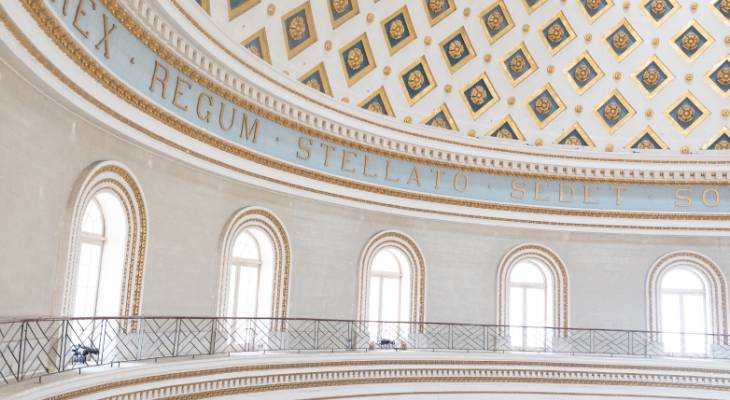
“The style of the master shines through each of these pieces, especially his signature palette of colours together with his inimitable style,” Angela explains. The episodes include the Birth of Jesus, the Visitation of the Magi, Jesus teaching in the Temple, Jesus’ meeting with Mary Magdalene and the Resurrection; amongst others.
“When I notice someone who is especially interested in the art of the church, I approach them and ask them if they would be interested in some more information about what they would be looking it. Many times, they would be interested, and I would be more than happy to provide them with some extra information which perhaps wouldn’t be available on the church museum’s informative app,” Angela quips. “Italians tend to be more interested since Calí was Italian himself.”
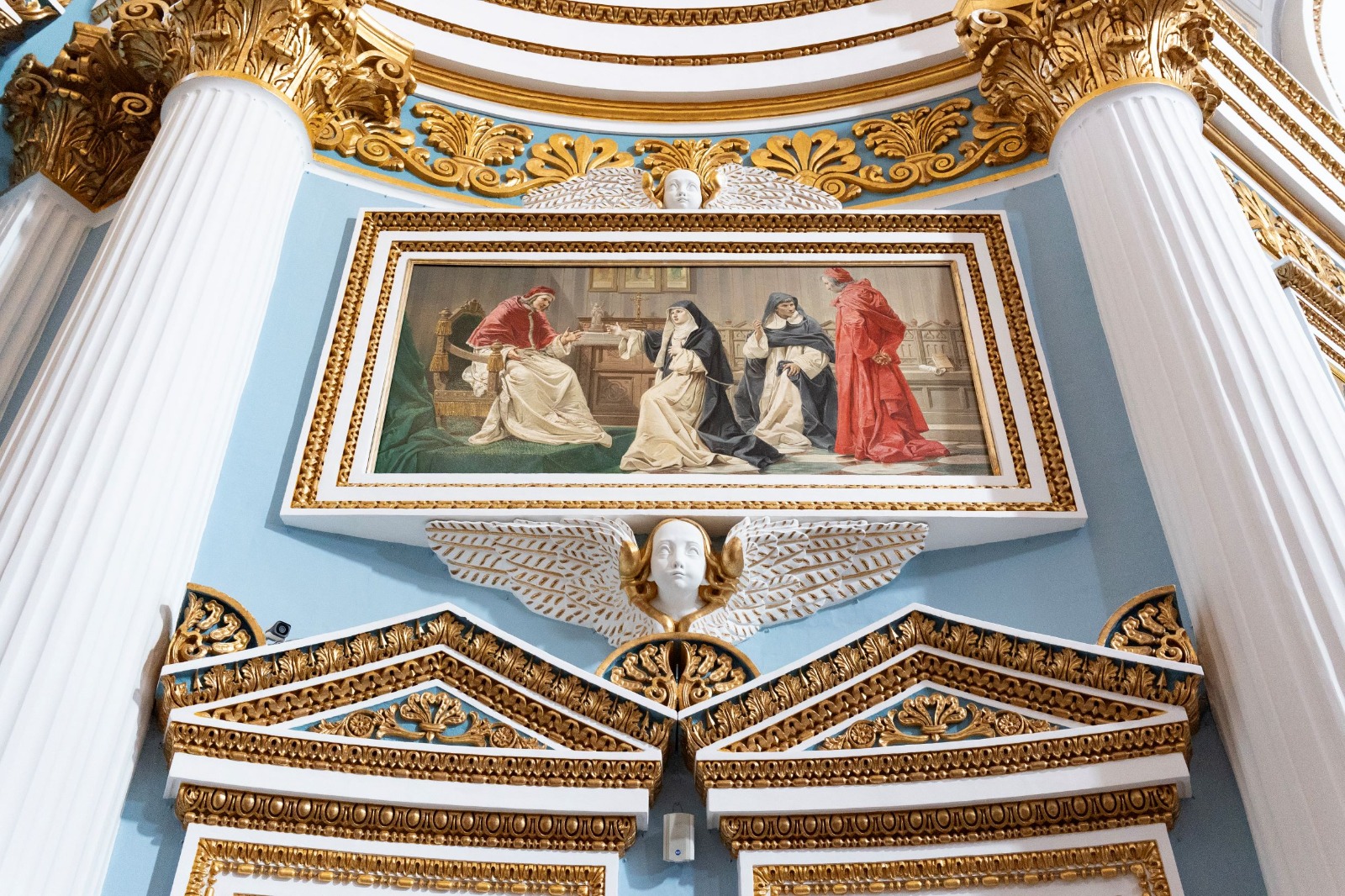
Detail of interior artwork
Right beneath each of the pendentives are depictions of prophets from the Old Testament with signature quotes in Latin. All done by the same artist. “The prophets, the quote and the episodes from the life of Jesus all relate to one another, underlining the running theme of continuity in the grand narrative of salvation,” Angela explains. “I take great interest in this topic, especially the Theology of Art. In fact, I double-checked each of these inscriptions personally in my own bible and they all check through.” Angela reassures.
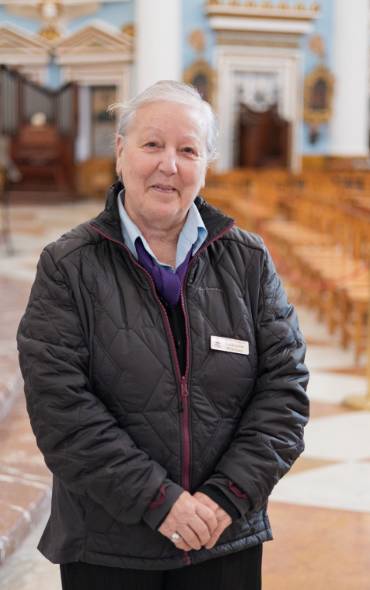
Angela Farrugia
My private guide also tells me that, like any great master worth his mettle, Calí would often choose people from the streets to pose in for his holy characters. “Tradition says that the Prophet Isiah was modelled on my grandfather’s great grandfather. In fact, many people claim that characters are based on their ancestors. It’s hard to verify these facts as photography was an extreme luxury at the time, but it’s nice to think that our forefathers are in fact embellishing the church.”
Art in the Mosta church, however, is not just about Calí. Stefano Erardi, another local master, painted the titular painting as well as many other pieces which were carried over from the smaller old church that existed before the rotunda. The Archangels in the choir of the church are a more recent addition which was completed in the 20th Century by celebrated Mosta sculptor Vincent Apap.
One eye-catching detail is a hooded man on the apse, who has fuelled speculation and imagination about his identity or intentions for a hundred years.
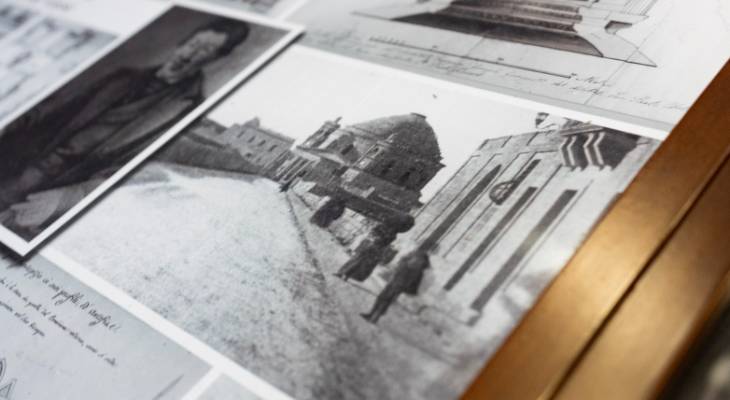
“We don’t know who he is, but he could be anyone one of us,” Angela remarks philosophically. “We all see our selves in that hooded man, in the most beautiful and prominent place of our beloved church,” Angela reflects.
Phyllis wears the historian hat, as she recounts the famous World War II story, when an Axis bomb pierced through the dome of the rotunda, and into a packed church. While she was not born yet, on that fateful 9th April 1942, she was raised in a household where the memory of the bomb was very much alive, as all her older relatives where there, and witnessed the horrors of the episode first hand.
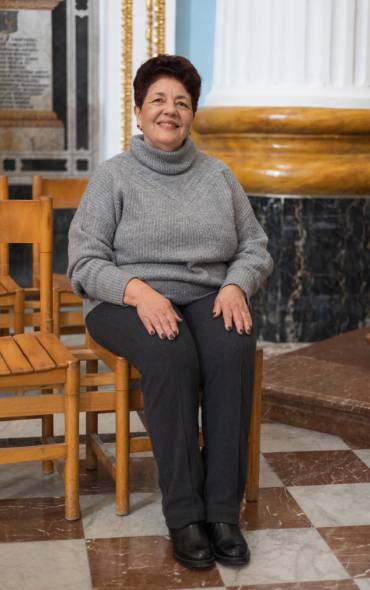
Phyllis D'Arró
“It was around 4:40pm, when the bomb struck. Malta was going through one of the heaviest bombing periods in its history, with multiple air-raids happening every day. Few people know that in fact, three bombs were dropped onto the church. One brazed the left-belfry and ended up falling in front of the church, the second fell behind the rotunda, but the third famously penetrated through the dome. Some 300 parishioners were in the church attending Ora Santa, or Holy Adoration, when the bomb broke through the ornate ceiling, travelled at lightning speed across the church, smacked against one of the pendentives, and dropped to the floor without exploding, much to everyone’s astonishment!”
Talk of a real miracle spread across the island like wildfire, as hope was in very short supply that harrowing April.
“My mother used to tell us how all the glass panes in the church exploded as soon as the bomb broke through the ceiling, throwing shards of glass in all directions. The real miracle is that everyone walked out of the church without a scratch after this dreadful episode. No one was injured, not from the falling debris of the ceiling, not from the exploding glass, and most significantly not from the enormous weapon that could have wrecked untold destruction that day. Only one of Calí’s episodes was damaged, as the half-tonne bomb hit the images of Jesus right in the face.”
Naturally the poetry of such an amazing coincidence was not lost on anyone.
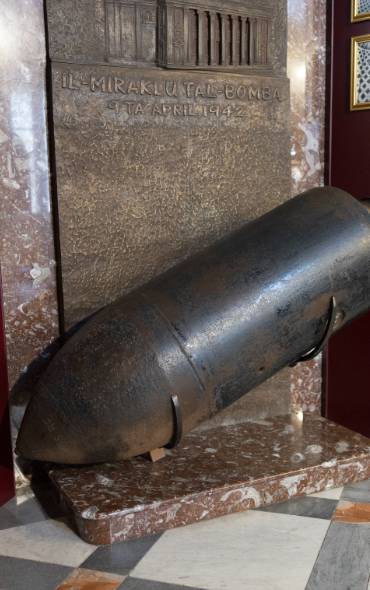
Rotunda Museum - WWII Bomb
“I might not have been there physically, but I feel the episode is part of who I am, and I form part of the story as much as any one of those 300 faithful, who were in the church. My mother would always tell us that after all this, not one candle on the altar was spent and this was an image that remained impressed in her head forever.”
“Restoration of the dome took place immediately, and the damaged painting was restored by Calí’s nephew Raphael. As a child I remember making it a point to walk over the damaged marble paving which was temporarily fixed with cement for a while.”
Phyllis also explains that an added element to the Mosta war-time experience is the air-raid shelter which was hewn from solid rock during the years of the war by two Mosta men, by hand. The shelter is open for visitors, who will be able to experience life during those dreaded Axis bombings.
To learn more about the Mosta Rotunda Museum click here.